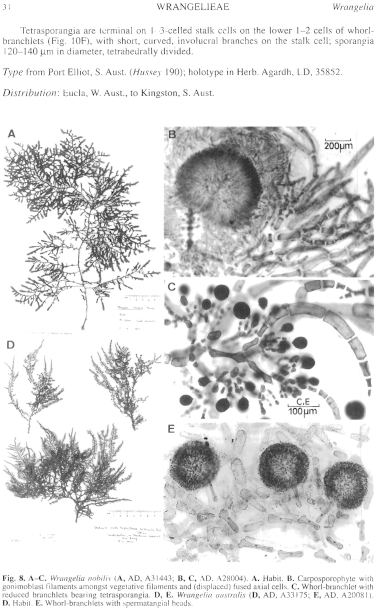|
|
|
|
|
|||||||||||
|
Electronic Flora of South Australia Species Fact Sheet
Phylum Rhodophyta – Order Ceramiales – Family Ceramiaceae – Tribe Wrangelieae
Synonym
Bracebridgea australis J. Agardh 1894a: 103, pl. 2 figs 1–3; 1899: 114. De Toni 1903: 1438; 1924: 504. Kylin 1956: 395, fig. 308C. Lucas 1909: 52. Lucas & Perrin 1947: 365. May 1965: 369.
Thallus (Fig. 8D) medium to dark red-brown, 10–22 cm high, largely complanately and alternately branched with long laterals 0.5–1 mm in diameter, fringed with short lateral branchlets 1–3 mm long surmounted by a tuft of filaments; lower branches 2–5 mm in diameter. Holdfast 2–6 mm across, rhizoidal; epilithic. Structure. Apical and subapical cells small, enlarging gradually to 200–250 µm in diameter and to 500 µm long near the base. Each subapical cell cutting off 5 periaxial cells in alternating sequence, developing into pseudodichotomous whorl-branchlets 2–4 mm long, branched 5–6 times, median cells 45–65 µm in diameter and L/D 1.5–2 (–3), terminal cells mucronate; first and second whorl-branchlets become villose (Fig. 10A) and alternately pinnate, forming the terminal tufts on the short lateral branches. Indeterminate lateral branches arise from the basal cells of second-formed whorl-branchlets and are thus distichous on alternate sides of the main branches. Cortication by descending rhizoids from the basal cells of whorl-branchlets, developing below an outer cortex (Fig. 10B) of branched anticlinal filaments (Fig. 10C) 45–60 µm in diameter with subspherical terminal cells 90–125 µm in diameter; lower axes often denuded of whorl-branchlets in older plants, leaving only the cortex of anticlinal filaments. Cells uninucleate; rhodoplasts discoid.
Reproduction: Gametophytes dioecious. Procarps (Fig. 10D) formed as in W. nobilis, carpogonial branches 4-celled (rarely 5-celled), formed on successive subapical cells. Carposporophyte with intermixed sterile whorl-branchlets, the whole 1–1.8 mm across, carposporangia clavate, 45–120 µm in diameter. Spermatangial heads (Fig. 8E) subspherical, 100–180 µm in diameter, borne on 1–2-celled stalks (Fig. 10E) on lower cells of the whorl-branchlets on young indeterminate branches with much reduced involucral branches 1–2 cells long on the stalk cell.
Tetrasporangia are terminal on 1–3-celled stalk cells on the lower 1–2 cells of whorl-branchlets (Fig. 10F), with short, curved, involucral branches on the stalk cell; sporangia 120–140 µm in diameter, tetrahedrally divided.
Type from Port Elliot, S. Aust. (Hussey 190); holotype in Herb. Agardh, LD, 35852.
Selected specimens: Eucla, W. Aust. (Herb. Agardh, LD). Elliston, S. Aust., 7 m deep (Shepherd, 21.x.1970; AD, A37578), Off Troubridge Light, S. Aust., 18 m deep (Shepherd, 4.ii.1969; AD, A33562). Tapley Shoal, off Edithburg, S. Aust., 10 m deep (Shepherd, 2.ii.1969; AD, A33175). Seal Bay, Kangaroo 1., S. Aust., drift (Womersley, 22.xi.1968; AD, A32174). Pennington Bay, Kangaroo I., S. Aust., drift (Womersley, 11.ii.1956; AD, A20120). Stanley Beach, S coast Kangaroo I., S. Aust., drift (Womersley, 7.ii.1956; AD, A20081, and 6.ii.1957; AD, A20910). Kingston, S. Aust., drift (Womersley, 9.viii.1961; AD, A24875).
Distribution: Eucla, W. Aust., to Kingston, S. Aust.
Taxonomic notes: W. australis is distinguished by its largely complanately branched thalli, with short distichous branches along long laterals, and by the outer cortex of filaments with subspherical, swollen, terminal cells.
It appears to be a deeper water alga on moderate to rough-water coasts.
References:
AGARDH, J.G. (1894a). Analecta Algologica. Cont. I. Acta Univ. lund. 29, 1–144, Plates 1, 2.
AGARDH, J.G. (1899). Analecta Algologica. Cont. V. Acta Univ. lund. 35, 1–160, Plates 1–3.
DE TONI, G.B. (1903). Sylloge Algarum omnium hucusque Cognitarum. Vol. 4. Florideae. Sect. 3, pp. 775–1521 + 1523–1525. (Padua.)
DE TONI, G.B. (1924). Sylloge Algarum omnium hucusque Cognitarum. Vol. 6. Florideae. (Padua.)
GORDON, E.M. (1972). Comparative morphology and taxonomy of the Wrangelieae, Sphondylothamnieae and Spermothamnieae (Ceramiaceae, Rhodophyta). Aust. J. Bot. suppl. 4, 1–180.
KYLIN, H. (1956). Die Gattungen der Rhodophyceen. (Gleerups: Lund.)
LUCAS, A.H.S. & PERRIN, F. (1947). The Seaweeds of South Australia. Part 2. The Red Seaweeds. (Govt Printer: Adelaide.)
LUCAS, A.H.S. (1909). Revised list of the Fucoideae and Florideae of Australia. Proc. Linn. Soc. N.S.W. 34, 9–60.
MAY, V. (1965). A census and key to the species of Rhodophyceae (red algae) recorded from Australia. Contr. N.S.W. natn. Herb. 3, 349–429.
The Marine Benthic Flora of Southern Australia Part IIIC complete list of references.
Publication:
Womersley, H.B.S. (24 December, 1998)
The Marine Benthic Flora of Southern Australia
Rhodophyta. Part IIIC. Ceramiales – Ceramiaceae, Dasyaceae
©State Herbarium of South Australia, Government of South Australia
Illustrations in Womersley Part IIIA, 1998: FIGS 8D, E, 10.

Figure 8 enlarge
Fig. 8. A–C. Wrangelia nobilis (A, AD, A31443; B, C, AD, A28004). A. Habit. B. Carposporophyte with gonimoblast filaments amongst vegetative filaments and (displaced) fused axial cells. C. Whorl-branchlet with reduced branchlets bearing tetrasporangia. D, E. Wrangelia australis (D, AD, A33175; E, AD, A20081). D. Habit. E. Whorl-branchlets with spermatangial heads.

Figure 10 enlarge
Fig. 10. Wrangelia australis (A, AD, A32174; B, C, AD, A20910; D, AD, A33175; E, AD, A20081; F, AD, A20120). A. A whorl-branchlet with villose upper part. B. Transverse section of older corticated axis. C. Longitudinal section with axis and rhizoids, and cortical filaments. D. Branch apex with carpogonial branches. E. Longitudinal section of a spermatangial head. F. Whorl-branchlet with tetrasporangia. (All as in Gordon 1972, courtesy of Aust. J. Bot.)

|
Email Contact: State Herbarium of South Australia |

|